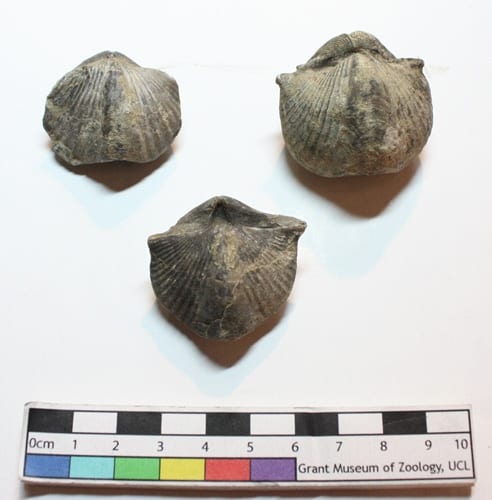Specimen of the Week 263: The fossil brachiopods
By Jack Ashby, on 28 October 2016
Some animals are most commonly defined by what they are not. The first thing that most people say about horseshoe crabs, for example is that they are not crabs. Likewise flying lemurs are not lemurs, camel spiders are not spiders and golden moles are not moles*. I kind of feel sorry for these animals that are denied a unique description of their own in this way; their status as being “not something else” is given as the most interesting thing about them. This week’s Specimen of the Week is one such animal.
**The fossil brachiopods**
Brachiopods are not bivalves
The first thing that is most often said about brachiopods is that they are not bivalve molluscs. Bivalves are the huge class of molluscs that are characterised by having two shells (called valves) – one on the left and one on the right. Brachiopods also have two shells, but they have one on the top and one on the bottom. Most bivalves are roughly symmetrical down the plane of their two valves (each shell is normally roughly a mirror image of the other), while most brachiopods are roughly symmetrical down the plane that runs across the midpoint of their shells: their left side is roughly a mirror image of their right). They open their two shells slightly, and pump in water by waving little tentacle covered in cilia, and filter tiny particles for food.

The inside and outside of the “top” (dorsal) shell of a Spirifer brachiopod, including the internal spiral structures which support the filter feeding apparatus and gives the animal their name.
Brachiopods are not molluscs
Brachiopods are not molluscs – they belong to an entire phylum of their own. A phylum (plural phyla) is the largest of the main taxonomic subcategories (after “Kingdom: Animal”, it goes Phylum, Class, Order, Family, Genus, Species) and there are approximately 35 phyla (there are disagreements about whether some groups are distinct enough to be classified as a phylum). You can see most of them in the first display case as you come through the door in the Museum (titled “One of Everything). Mollusca is one phylum, Brachiopoda is another. A bodyplan with a pair of two shells has evolved independently in the bivalves molluscs and the brachiopods. This is the first time a brachiopod has featured in more than five years since Specimen of the Week first evolved.
Brachiopods are not deuterostomes
I’ll admit that this is not normally high among the list of things that people say about brachiopods. Deuterostomes are a huge grouping of animals (actually at the “superphylum” level which includes echinoderms (such as starfish and sea urchins) and chordates (which is mostly comprised of the vertebrates, including us). Brachiopods were long considered close relatives of the echinoderms and chordates, which some might say made them interesting from the purely egotistical view that things that are related to humans are interesting (I’m not saying I subscribe to that view). However, in recent years comparing the genetic and other molecular data across invertebrate groups has shown that brachiopods do not belong to this grouping. Instead they fall in to a massive grouping (the Lochotrophozoa) with ribbon worms, bryozoans, annelid worms and – as it would turn out – molluscs.
Brachiopods are not extinct
But they have had their heyday. Brachiopods have a vast fossil record – they first appeared in the Early Cambrian Period, around 550 million years ago. They were extremely common throughout the Palaeozoic Era, even forming vast reefs. Over 12,000 fossil species have been recognised. They survived the “Great Dying” at the end of the Permian Period, when 70% of life on land became extinct, along with a staggering 96% of marine species. However they began to decline after that. Today they are only represented by a tiny fraction of what came before. It is believed that they were outcompeted by a growing diversity of bivalve mollucs.
*not to mention that flying lemurs can’t fly, camel spiders don’t eat camels (as was once thought) and it would be very generous to describe the brown fur of golden moles as golden.
Jack Ashby is the Manager of the Grant Museum of Zoology
One Response to “Specimen of the Week 263: The fossil brachiopods”
- 1
 Close
Close



Takes me back to my undergraduate palaeontology days at Kingston.